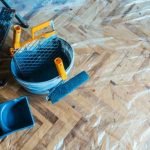Are you a homeowner looking for ways to save money? One often overlooked opportunity is claiming home improvement expenses on your taxes. Understanding the tax benefits of home improvements can not only help you reduce your tax liability but also provide financial relief.
By taking advantage of available tax deductions and credits, you can potentially save thousands of dollars. In this article, we will explore how to claim home improvements on your taxes, the types of expenses that qualify, and strategies for maximizing your tax benefits.
When it comes to owning a home, there are many expenses involved in maintaining and improving the property. What homeowners may not realize is that certain home improvements can result in valuable tax deductions and credits. By claiming these eligible expenses on your taxes, you can effectively reduce the amount of taxable income and potentially increase your refund or decrease any owed taxes. This method allows you to leverage the money spent on enhancing your property into substantial savings.
To take advantage of these tax benefits, it’s crucial to understand which home improvements qualify for deductions or credits. Expenses like installing energy-efficient systems, such as solar panels or geothermal heat pumps, can qualify for residential energy credits. Remodeling a home office or making modifications for accessibility purposes may also be eligible under specific circumstances. By focusing on qualifying improvements and properly documenting your expenses, you can ensure that you’re maximizing the tax benefits available to you.
In this article, we will delve into the various aspects of claiming home improvement expenses on your taxes. We’ll explore which expenses are eligible for deductions or credits, how to keep accurate records and create a budget for documentation purposes, as well as navigate forms like IRS Form 5695 for residential energy credits. Additionally, we’ll discuss deductible versus non-deductible expenses so that homeowners have a clear understanding of what qualifies for tax savings.
Furthermore, we’ll provide practical tips on hiring professionals versus opting for do-it-yourself projects and offer tax planning strategies to help you time and spread out your home improvement costs effectively. Finally, we will also outline common mistakes to avoid in order to ensure accurate tax reporting.
By the end of this article, you’ll have a comprehensive understanding of how to claim home improvements on your taxes, saving money and maximizing your financial gain as a homeowner. So let’s dive in and uncover the tax benefits waiting for you.
Qualifying Home Improvements
Types of Home Improvements
When it comes to claiming home improvement expenses on your taxes, it is essential to understand which expenses qualify for tax deductions. The IRS allows deductions for specific types of home improvements that are considered to add value to your property or promote energy efficiency.
One common example of a qualifying home improvement expense is the installation of energy-efficient systems. This can include solar panels, geothermal heat pumps, or wind turbines. These upgrades not only benefit the environment but also provide significant tax benefits for homeowners.
Remodeling a home office is another expense that qualifies for tax deductions. With the rise of remote work and freelance opportunities, many individuals have created dedicated office spaces within their homes. When you remodel your home office and make improvements such as adding insulation, upgrading wiring, or installing built-in shelving, these expenses can be deducted from your taxes.
Eligibility Requirements
While there is no exhaustive list of eligible home improvement expenses provided by the IRS, it’s important to note that general repairs and maintenance expenses do not qualify for tax deductions. Only improvements that increase the value or prolong the useful life of your property are eligible.
Additionally, if you use a portion of your home exclusively for business purposes, you may be eligible to claim a portion of your home improvement expenses as business deductions. However, it’s crucial to consult with a tax professional to ensure you meet all the requirements and accurately report these expenses.
Additional Considerations
When determining whether an expense qualifies as a home improvement for tax purposes, there are several factors to consider. First, the expense must be directly related to improving your primary residence; expenses incurred on vacation homes or rental properties may not be eligible.
Secondly, it’s crucial to keep in mind that claiming these deductions may require you to itemize your deductions rather than taking the standard deduction. This means keeping meticulous records of your expenses and maintaining a well-organized filing system.
By understanding the types of home improvements that qualify for tax deductions and carefully documenting your expenses, you can optimize the financial benefits available to homeowners. Consult with a tax professional or refer to IRS publications for detailed guidance specific to your situation.
Documentation and Budgeting
One of the key aspects of claiming home improvement expenses on your taxes is keeping accurate records and effectively documenting your expenses. This not only helps you in accurately reporting your deductions but also provides a sense of organization and control over your budget. Here are some tips on how to keep track of home improvement costs:
- Save receipts and invoices: Make sure to keep all receipts and invoices related to your home improvement projects. Whether it’s for materials, labor, or professional services, having these documents will be crucial when it comes time to report your expenses. Consider creating a filing system or using digital tools to organize and store these documents for easy access.
- Maintain a project log: Keep a detailed log that tracks the progress of each home improvement project you undertake. Include important information such as the start date, end date, description of the work done, contractor details (if applicable), and costs incurred at each stage. This log will serve as a comprehensive reference for all your expenses, making it easier to calculate deductions later on.
- Create a separate budget for home improvements: It’s essential to have a clear understanding of how much you are spending on home improvements throughout the year. By creating a separate budget specifically for these projects, you can track your expenses more effectively and avoid any surprises at tax time. Consider using personal finance software or spreadsheets to create a budget that includes estimated costs as well as actual expenditures.
By following these documentation and budgeting practices, you can ensure that you have all the necessary information to accurately claim your home improvement expenses on your taxes.
| Expense | Amount | Date | Receipt/Invoice |
|---|---|---|---|
| Roof Replacement | $15,000 | May 2021 | Receipt |
| Energy-efficient HVAC system installation | $7,500 | February 2021 | Invoice |
| Kitchen Remodeling | $25,000 | June-July 2021 | Receipts (multiple) |
Form 5695
One of the key ways homeowners can maximize their tax benefits when it comes to home improvements is by claiming residential energy credits. The IRS Form 5695 is specifically designed for this purpose and allows homeowners to claim credits for making energy-efficient upgrades to their homes. This section will explain the purpose and significance of Form 5695 and provide a step-by-step guide on how to correctly fill out the form.
Form 5695 serves as a comprehensive tool for homeowners to claim various credits related to energy-efficient improvements made to their homes. These credits can help offset some of the costs incurred during these projects, ultimately saving homeowners money. Some of the most common energy-efficient upgrades that qualify for residential energy credits include installing solar panels, wind turbines, geothermal heat pumps, and energy-efficient windows or doors.
To correctly fill out Form 5695, follow these steps:
- Start by entering your name and Social Security number at the top of the form.
- Next, you’ll need to determine which type of credit you are eligible for: either the nonbusiness energy property credit or the residential energy efficient property credit.
- If you are claiming the nonbusiness energy property credit, proceed to Part I of Form Here you will enter information about your eligible expenses such as costs related to insulation, roofing materials, energy-efficient heating and cooling systems, and more.
- If you are claiming the residential energy efficient property credit, proceed to Part II of Form This section is used for renewable energy improvements such as solar panels or wind turbines.
- It’s important to note that each line item on the form has specific instructions regarding what information needs to be provided and what documentation may be required.
- Once you have completed all relevant sections based on your eligibility, calculate your total qualified expenses and transfer this amount onto your main tax return.
By correctly completing Form 5695, homeowners can take full advantage of residential energy credits and potentially receive significant savings on their tax bill. It is crucial to keep accurate records and retain any supporting documentation for eligible expenses as the IRS may request verification in the future. Remember to consult with a tax professional or refer to IRS guidelines for more detailed information on how to claim residential energy credits and maximize your tax benefits.
Deductible vs Non-Deductible Expenses
One important aspect of claiming home improvement expenses on your taxes is understanding the difference between deductible and non-deductible expenses. Deductible expenses are costs that can be subtracted from your taxable income, resulting in a lower overall tax burden. On the other hand, non-deductible expenses cannot be claimed as tax deductions.
Deductible home improvement expenses typically fall into categories such as energy efficiency upgrades, medical necessity modifications, or improvements related to business use. Examples of deductible expenses include installing solar panels, adding insulation, or remodeling a home office.
Non-deductible expenses are those that do not meet the criteria set by the IRS for tax deductions. These may include general repairs and maintenance, cosmetic enhancements, or improvements made purely for personal enjoyment. While these expenses may enhance the value or comfort of your home, they cannot be claimed as deductions on your taxes.
Understanding which home improvement expenses are deductible and which are not can help you effectively plan and budget for projects. By focusing on eligible deductions, you can maximize your tax benefits and potentially save a significant amount of money.
Maximizing Tax Benefits
When it comes to home improvements, homeowners not only get the benefit of a more comfortable and modern living space, but they can also take advantage of tax credits and deductions. These financial incentives are designed to encourage homeowners to make energy-efficient upgrades or renovate their homes. By understanding and utilizing these tax benefits, homeowners can maximize their savings and potentially receive a hefty return on their investment.
Tax Credits for Energy-Efficient Home Improvements
One of the most lucrative tax benefits available to homeowners is the Residential Energy Efficient Property Credit. This credit allows homeowners to claim a percentage of the costs associated with installing energy-efficient systems such as solar panels, geothermal heat pumps, or wind turbines. The percentage varies depending on the type of system installed, but it can range from 10% to 30% of the installation cost.
It is important for homeowners to keep in mind that this credit has a total lifetime limit of $500 per half kilowatt hour capacity. To claim this credit, homeowners must complete IRS Form 5695.
Deductions for Home Office Expenses
For those who work from home or run a business out of their homes, deducting home office expenses is another way to maximize tax benefits. The key requirement for claiming home office deductions is that the space used for business purposes must be exclusively dedicated to work activities.
This means that a portion of mortgage interest or rent payments, utilities, and property taxes can be deducted based on the percentage of your home that is used as an office space. To determine this deduction accurately, it is recommended to use either the simplified option (which involves a predetermined rate multiplied by the square footage) or calculate actual expenses based on specific variables.
Taking Advantage of Additional Tax Credits and Deductions
In addition to residential energy credits and home office deductions, there are several other tax benefits that homeowners can take advantage of when it comes to home improvements. Some examples include the Nonbusiness Energy Property Credit, which allows for a tax credit on qualified energy-efficient upgrades such as insulation, windows, and doors, and the Mortgage Interest Deduction, which allows homeowners to deduct the interest paid on their mortgage.
Researching and understanding these various tax credits and deductions can help homeowners effectively plan their home improvement projects and maximize their overall tax benefits.
By taking advantage of these tax credits and deductions, homeowners can significantly reduce their taxable income and potentially receive a sizeable refund. However, it is important to be aware that tax laws and regulations are subject to change, so staying up-to-date with current IRS guidelines is essential.
Consulting with a tax professional or using trusted tax software can also provide valuable guidance in navigating the complexities of claiming home improvement expenses on taxes. Ultimately, by being proactive in understanding and utilizing these financial incentives, homeowners can make their home improvement projects more cost-effective while enjoying the many benefits of an upgraded living space.
Hiring Professionals vs DIY
When it comes to home improvements, one of the decisions homeowners often face is whether to hire professionals or tackle the projects themselves. This choice not only affects the overall cost and quality of the work but also has implications for tax deductions. Understanding these implications can help homeowners make an informed decision that maximizes their financial benefits.
Hiring Professionals
- One advantage of hiring professionals for home improvement projects is that their labor costs may be deductible.
- These deductions can include expenses for various trades such as plumbers, electricians, carpenters, and landscapers.
- Homeowners should ensure that they receive accurate invoices or receipts from the professionals they hire to provide evidence of the expenses being claimed.
DIY Projects
- While labor costs for DIY projects are not tax deductible, homeowners may still be eligible for deductions on materials and supplies used.
- To qualify for these deductions, it is crucial to keep accurate records of all purchases made during the home improvement project.
- This includes saving receipts for items such as paint, flooring materials, light fixtures, landscaping materials, and any other expenditures directly related to the project.
It’s important to note that when deciding between hiring professionals or doing it yourself, homeowners should consider their skill level and available time. DIY projects can save money on labor costs but may require a significant amount of time and effort. On the other hand, hiring professionals ensures expertise and potentially faster completion but at a higher upfront cost.
By carefully considering these implications when deciding whether to hire professionals or pursue DIY projects, homeowners can make choices that optimize their tax deductions while creating a comfortable living space. Remembering to keep accurate records regardless of which route is chosen will help support anyclaims made on future tax returns.
Tax Planning Strategies
Timing and spreading out home improvement costs can be a strategic tax planning strategy that homeowners can utilize to maximize their tax benefits. By carefully planning when to undertake home improvement projects, homeowners can take advantage of tax deductions and credits more effectively.
One important consideration when it comes to timing home improvement projects is the tax year in which expenses are incurred. In order to claim tax deductions or credits for a specific year, the expenses must be paid or incurred within that year. This means that if you are aiming to claim an expense on your taxes for a particular year, you need to ensure that the payment is made before the end of that tax year.
Additionally, homeowners should consider spreading out their home improvement costs over multiple years to fully benefit from available tax credits and deductions. By strategically planning projects and spacing them out over time, homeowners may be able to claim larger tax breaks by maximizing their eligible expenses in different years. Spreading out expenses can also help minimize any potential negative impacts on annual income thresholds for certain tax credits or deductions.
Another factor to consider when timing and spreading out home improvement costs is how they may impact other financial goals or obligations. It’s important for homeowners to carefully assess their overall financial situation and determine what is most feasible and advantageous in terms of timing their projects. For example, if a homeowner plans to sell their property in the near future, it might make sense to prioritize certain improvements that could increase its market value.
Common Mistakes to Avoid
When it comes to claiming home improvement expenses on your taxes, accuracy is key. Making mistakes in tax reporting can result in missed deductions or even an audit from the Internal Revenue Service (IRS). To ensure that you report your home improvement expenses correctly and maximize your tax benefits, it’s important to avoid common mistakes. Here are some tips for accurate tax reporting:
- Failing to keep detailed records: One of the biggest mistakes homeowners make when claiming home improvement expenses is not keeping accurate and detailed records. It’s crucial to keep receipts, invoices, and any other documentation related to your home improvement projects. These records will serve as proof of the expenses incurred and help support your claims if you ever get audited.
- Incorrectly classifying deductible expenses: Another common mistake is improperly classifying deductible expenses. Not all home improvement expenses are eligible for tax deductions, so it’s important to understand the difference between deductible and non-deductible expenses. For example, cosmetic improvements like painting a room or installing new carpeting do not qualify for tax deductions, while energy-efficient upgrades or renovations for medical purposes may be eligible.
- Overestimating the value of improvements: When claiming home improvement expenses on your taxes, it’s important to accurately determine the value of the improvements made. Overestimating the value can lead to inflated deductions or discrepancies in your tax return. It’s a good idea to consult with professionals such as real estate appraisers or contractors who can provide accurate estimates.
- Ignoring changes in tax laws: Tax laws are subject to change, and failing to stay updated on these changes can result in errors when reporting home improvement expenses. Stay informed about any updates or revisions made by the IRS regarding eligible deductions or credits for home improvements.
By keeping up-to-date with current tax laws, you’ll be able to accurately report your expenses and ensure that you’re taking advantage of all available tax benefits.
By avoiding these common mistakes, you can ensure accurate tax reporting and maximize your tax benefits from home improvement expenses. Remember to keep detailed records, correctly classify deductible expenses, accurately determine the value of improvements, and stay informed about changes in tax laws. Claiming home improvement expenses on your taxes can lead to significant savings and financial gain, so it’s worth taking the time to report them accurately.
Conclusion
In conclusion, understanding and claiming home improvement expenses on taxes is a win-win situation for homeowners. Not only can it help reduce the financial burden of home renovations and improvements, but it can also provide significant tax benefits. By taking advantage of the various deductions and credits available, homeowners can save money and potentially increase their tax refunds.
Throughout this article, we have discussed the qualifying home improvements that are eligible for tax deductions, the importance of keeping accurate records and creating a budget, as well as the significance of IRS Form 5695 in claiming residential energy credits. We have also explored the difference between deductible and non-deductible expenses and provided tips on maximizing tax benefits.
Furthermore, we have examined how hiring professionals or opting for DIY projects can impact tax deductions. Additionally, we have discussed strategic timing of home improvement projects to maximize tax benefits and the advantages of spreading out expenses over multiple years.
It is crucial for homeowners to avoid common mistakes when claiming home improvement expenses by accurately reporting their taxes. By understanding these key points and ensuring accurate tax reporting, homeowners can navigate through the complexities of tax regulations while maximizing their financial gain.
Frequently Asked Questions
Can you write off home improvements on taxes?
Whether or not you can write off home improvements on taxes depends on the nature of the improvement and your specific circumstances. Generally, home improvements that increase the value of your property, such as adding a new room or renovating a kitchen, may be eligible for certain tax deductions.
However, it is important to note that ordinary repairs and maintenance expenses are generally not tax-deductible. It is advisable to consult with a tax professional or refer to the guidelines provided by the relevant tax authority in your country to determine which home improvements qualify for tax write-offs.
What happens if you don t have receipts for home improvements?
If you don’t have receipts for home improvements, it can make it challenging to accurately document your expenses when claiming deductions on your taxes. While receipts serve as evidence of your expenditures and provide necessary documentation for tax purposes, they are not always required by tax authorities.
In many cases, other forms of proof such as invoices, bank statements, credit card statements, or cancelled checks may be used as supporting evidence instead. However, it’s important to note that relying solely on verbal assertions without any verification can potentially lead to complications during an audit or when substantiating your claims in case of scrutiny.
Can you write off new flooring on your taxes?
The deductibility of new flooring expenses on your taxes also depends on various factors and often falls into a gray area as far as eligibility goes. In general, if you install new flooring solely for aesthetic purposes without any functional benefit tied to energy efficiency or medical necessity (e.g., allergy reduction), it might not qualify for tax write-offs.
However, in certain situations where flooring installation is deemed essential for medical purposes or improves energy efficiency significantly (e.g., installing energy-efficient insulation below the floor), there could be potential deductions available. Consulting with a tax professional would be beneficial to determine whether or not you can write off new flooring expenses based on your unique circumstances and applicable regulations.

I’m thrilled to have you here as a part of the Remodeling Top community. This is where my journey as an architect and remodeling enthusiast intersects with your passion for transforming houses into dream homes.





